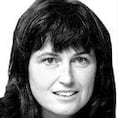New infants are celebrated wide and far but not every baby can claim to have been sketched by its artist mother within hours of being born. There are exceptions. The wonderful Swedish-speaking Finnish original Tove Jansson, creator of the Moomin stories and a syndicated comic strip that appeared in 120 newspapers across the world, born in Helsinki 100 years ago today, was sketched on the following day by her besotted illustrator mother, Signe Hammarsten.
Jansson was also a painter, illustrator, and extraordinary all-round writer who turned to adult fiction in middle age, writing six novels, including her finest work, The True Deceiver (1982) an astonishing exploration of truth and lies in which a young woman plots to impose herself upon an elderly female artist.
Signe, from Stockholm, was better known as "Ham". She had come to live in Helsinki on marrying Tove's father, the Finnish sculptor Viktor Jansson, on August 17th 1913. Tove was the first of their three children; two sons were to follow. Having just given birth, Signe began The Book of Our Sunday Child. It must be said that the future artist/ writer looks quite terrifying, both head on and in profile. Her mother agreed, recording in elegantly classical script: "She was born on Sunday 9th August at five minutes to twelve. It's nice she was a girl. But she was so ugly, awful!"
Mother and daughter went on to enjoy an intense and loving relationship. Grief at Signe’s death in July 1970, aged 88 (Tove was to live to be nearly 87), drew her daughter, then 56, to write dark, adult fiction, which has been appearing during the past few years in translation from the independent British publisher Sort of Books. No one writes like Jansson, understated, sophisticated and perceptive studies of human behaviour, often situated in snow and ice. Her magic may well rest in the fact that she never lost the clarity and oddly pragmatic fatalism with which a child reasons. Not surprisingly she wrote a play for children about the world ending.
There were reasons for this. Her imagination was shaped by war. Born in 1914, by the time she was three and half her father was away, fighting for Finnish independence in the Finnish Civil War. She and her mother lived with Signe's parents while he was away. He did return and was a volatile, charismatic character who indulged his pet monkey and also loved throwing impromptu parties. Young Tove learned to draw at her mother's side while Signe completed commissions. By the time Tove was 24 and already an artist, the second World War had begun. In The Family, a group portrait she painted in 1942, depicting her parents and her brothers, she is dressed in black; her expression is wary.
The first of the Moomin books, The Moomins and the Great Flood, appeared in late 1945. In it Moominmamma and Moomintroll are searching for a place to build a house, in the hope that Moominpappa, who had already set off on the same quest, will return. On the publication of the third Moomin book, she became famous. There would be 10 books, as well as spin-offs – an industry. Gradually she felt oppressed by their success and the tone does change in the later volumes. The final melancholic instalment, Moominvalley in November, written after her mother's death, is about returning to a now silent house.
The Summer Book was published in 1972 and tells the story of a six-year-old girl, a father and an elderly grandmother all living on an island in the Gulf of Finland. Jansson described the friendship her mother had with Sophia, the daughter of Tove's brother Lasse. Revered as a classic, it presented yet another side to the remarkable Jansson. It was the first of the 11 books she would write for adults, although by 1968, a decade after the death of her father, she had already written Sculptor's Daughter, an informal memoir combining autobiography and story.
One of the pieces in it is recalls her plan to sail away on an iceberg. Throughout her life, beginning in childhood, Jansson spent her summers with her parents, and later with her partner, fellow female artist Tuulikki Pietila, living on a remote island in the Gulf of Finland. Fair Play (1989) gives a sense of the work and love they shared together. As Tove Jansson grew old, she became frightened of the sea she had loved so well, spending her last years in Helsinki.
Her writing possesses extraordinary directness, as in Travelling Light (1987) published when she was 73. A Jansson story somehow makes the world, and humanity, that bit easier to understand.









